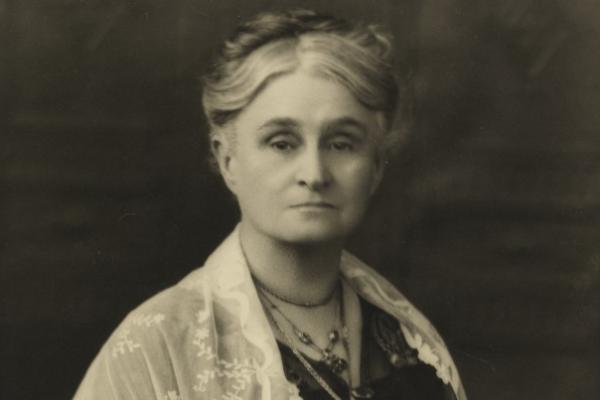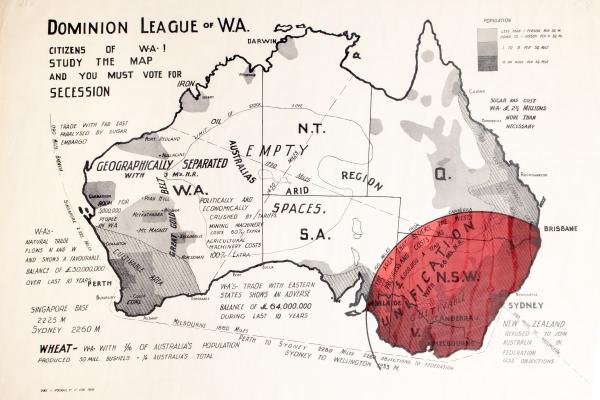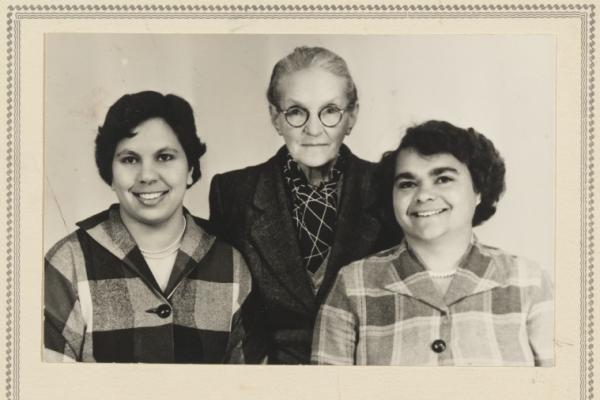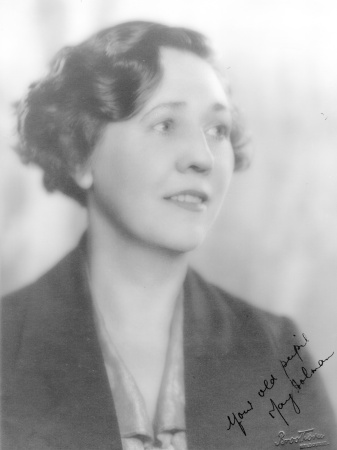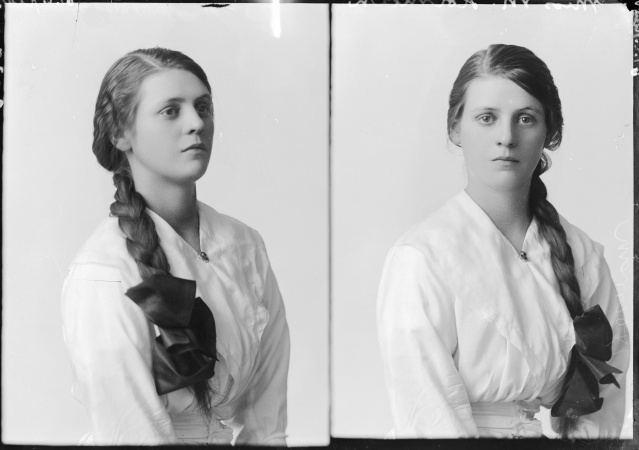Join Dr Kate as she explores the extraordinary life of May Holman, Australia’s first female Labor parliamentarian, a member of the WA Legislative Assembly from 1925 -1939. Holman led a trailblazing life which charted new territory for women.
In 1926, she was responsible for introducing one of the first pieces of worker health and safety legislation anywhere, the Timber Industry Act. This act improved the living and working conditions for employees and their families. Holman was deeply committed to improving society and campaigned on education reform, health reform, occupational health and safety reform plus equal pay for women and men.
The State Library holds a rich collection of material relating to May Holman, especially her private archive.
Recorded live on ABC Radio Perth on 18 March 2022.
Transcript
BEGINNING OF INTERVIEW
Christine: So, you would remember, late last year, the WA government announced a transition to end native forest logging in 2024 and 100 years ago, another historic moment in the history of forestry in the state was occurring. May Alice Holman was a household name in the twenties as Australia’s first female Labor parliamentarian. She was responsible for introducing the first piece of workers’ health and safety legislation for the timber industry in 1926, and to guide us through her life I have Dr Kate Gregory, Battye Historian from the State Library of WA.
Welcome back Kate.
Dr KG: Thank you Christine. It’s lovely to speak to you again.
Christine: Oh it’s so good to have you on after a long and deserved break.
Dr KG: Yes [laughs]
Christine: So, who was May Alice Holman?
Dr KG: I know, but look, as you said she was a household name in the 1930s. Really, really much loved public figure so, I guess as your introduction pointed out, we had this really significant announcement late last year which signalled a major change for forestry within WA with the preservation of native forests or no more native forest logging and yes, 100 years ago the forestry industry was very big within Western Australia and I guess it had grown from the 1890s especially with the gold rushes in WA and the demand for…I mean you’re talking about public works and public building.
Christine: Yes.
Dr KG: All sorts of things like the Fremantle bridge…the old Fremantle bridge that’s built of jarrah and many, many, many other public buildings. Wood was essential and there were many different sort of timber companies; mill companies in the South West, in the jarrah and karri forests and eventually in about 1900, all of those little smaller companies were amalgamated into a big conglomerate which was called the Millars’ Jarrah and Karri Company and this was actually a company that was kind of international so it had branches right through the Commonwealth and…which basically marketed and sold and produced West Australian timber for the international market as well as the local market. It was a huge industry and at the time in the 1920s I guess we’ve got to place ourselves in that moment and what was occurring and we’d just had World War 1, we’d had all of these returned servicemen coming back to Western Australia. Often, they were injured or damaged by the experience of World War 1 and there were various settlement schemes to get them back into work and labour and many times it was actually with the timber industry that those returned servicemen got jobs. There was also group settlement schemes in the South West for migrant families, lots of the group settlement schemes were failed projects really in that the people who…the families who were sort of making a go of the land didn’t have great success often and lived in extreme poverty.
So, there was a lot of social upheaval, a lot of change, and enter May Holman [giggles]. This is quite an amazing, dynamic woman who at the age of 31 makes history in 1925 by being elected to the Lower House of the WA State Parliament in a by-election. So, as a bit of background so you understand, she was actually filling a vacancy in the seat of Forrest which was left by the death of her own father John Holman.
Christine: Oh wow.
Dr KG: So, he had held the seat for just two years, but prior to that, he’d been a staunch Labor politician and parliamentarian for a number of decades so he’d started off in the Murchison area and then gone to the South West seat of Forrest and in fact May’s mother Katherine was also very active in the Labor party and Labor women’s organisations so she very much came from a Labor family and a trade union family as well; so her mother was very active and her father was very active and she was very much supported as a woman growing up in this environment.
Christine: Wow, so she had a lot of exposure to politics growing up.
Dr KG: A lot of exposure and very much the feeling was that she grew up in an atmosphere where men and women were treated equally and accredited with existing on the same intellectual plane. So, she had this basis and so she went forth and did amazing things and so she got re-elected. She got elected in the seat of Forrest and really I think in the years prior to that she’d gotten really closely involved with the Australian Timber Workers’ Union and got to know the people who were living in these small towns…mill towns. This is in…which was…it doesn’t exist anymore but it was the seat of Forrest with boundaries and it’s all changed but it was around Dwellingup as the kind of centre, so where you think of Jarrahdale and all of these mill towns that sprang up in that part of the South West. So, she spent a lot of time getting to know what the issues were with families and people and there was a lot poverty. She wasn’t alone in that she also relied on the work of another Labor woman Jean Beadle who was a little bit older than Jean, older than May, more her mother’s era but Jean had assembled a lot of material which highlighted and provided evidence I suppose on the working conditions and the living conditions of…
Christine: So, what was it like? What was it like for workers back then?
Dr KG: Well, what Jean Beadle found and May and they started assembling a lot of evidence around this, was that the conditions were terrible. People were having all sorts…I mean there were all sorts of workers’ accidents and there was a lot of poverty. They were living in really kind of impoverished circumstances sometimes. So, Jean Beadle found at the Kirup siding which was a little railway siding…timber railway siding that they were…people were living in…families living in crude hessian walled huts and with iron roofs and they were bitterly cold in the winter, baking hot in the summer and that there was lingering illness and sickness. There was, for instance, no midwifery at Jarrahdale Hospital and the nearest one was 25 miles away. There was lots of infant mortality and fatalities associated with the mill as well so it was really quite…the living conditions and working conditions were quite dire.
Christine: If you are living in those kinds of conditions you really are not going to be on the ball at work either and I can only assume that they would have been around some pretty dangerous equipment at that time in history.
20 minutes past 2.
Dr Kate Gregory is with me for History Repeated. We are talking about the history of May Alice Holman. So, what did they campaign for?
Dr KG: Well, yes.
Christine: Yes, what did they do?
Dr KG: Well basically, so May, she just devoted herself to bettering the conditions of the timber workers and their families and she succeeded and I think the most significant thing that…one of the most significant things that she achieved, remembering also she was in parliament for 14 years and re-elected five times and she was only the second woman after Edith Cowan, so she was trail blazing, just absolutely trail blazing, but what she did was she introduced the Timber Industry Regulation Act through parliament in 1926 and this had been based on the research that Jean Beadle and others had spent years assembling and it not only provided an assessment of the conditions of the South West forestry industry, but it also compared it with international examples to see where does this sit within the worldwide kind of…so it was really a significant piece of research and the legislation basically brought the control of the timber industry into one act rather than across three, and it enabled for example things like mill inspections to be carried out without advance warning. So, you can imagine that that was quite a significant thing because…
Christine: It would be.
Dr KG: …Had the mill managers known that some…that an inspector was coming, well they would only see the very best of the mill. They wouldn’t see what was actually going on. So, to be able to carry out those inspections without advance warning and also they were responsible for the safeguards to protect workers so all sorts of equipment regulations around not only the clearing of trees but also the infrastructure around it or the tram and train lines because you’ve got to think that all of this was conducted through this kind of complex network of tram and train lines so yes, and ventilation…proper ventilation, lighting, machinery guards, things that are absolutely taken for granted now as they rightly should be. At this stage, it was quite a significant piece of work because it was early legislation around occupational health and safety. So, it was really significant and I think also May…so there was the introduction of that in 1926 which was huge and then…
Christine: And you’ve got letters written by May Holman to her family whilst abroad. Where was she when she was writing those letters and what do they tell us?
Dr KG: Well, that’s right. So look, she was actually elected to represent Australia at the 1930 League of Nations Assembly.
Christine: Wow.
Dr KG: And it…I mean that was an amazing thing and yes…our collections, we’ve got these wonderful collections, so the Holman family papers and May Holman in particular and the letters she writes to her family and friends where…from Geneva are just this incredibly rich account of people who are involved with that League of Nations Assembly meeting but also she was appointed to the fifth commission on dangerous drugs and the general assembly on the traffic in women and children.
Christine: Wow!
Dr KG: So, …yes so, there’s a lot of detailed observations that she makes in these letters but as well as that, that’s the first…that’s the only time she goes abroad and so she’s making a lot of other observations about Australia and Australians and what it’s like to see Australia from Europe and she suddenly…you can see that she suddenly got a much bigger sort of world view and I think that’s really important and as well as the letters, we’ve got these beautiful postcards that she sent to her…to family members. She was quite a prolific writer and very verbose so she [laughs]…
Christine: Yes, yes.
Dr KG: She really loved the detail and so there’s beautiful character sketches and look it’s just a wonderful archive.
Christine: I’ve actually got Bailey listening who says, “May Holman was my great-aunt” on the text line.
Dr KG: Oh, wow!
Christine: And another text to say, “Fabulous story” and I read that by night, May was a bit of an entertainer. Can you tell me about that side of her life?
Dr KG: Yes, I know. Well this is this other side that’s wonderful to hear from Bailey though. Look, that’s right. So, May Holman, as well as being a very accomplished politician / parliamentarian, she was also a musician; very accomplished musician, really great singing voice and entertainer so, one of things that she did is she set up this troop of singers and performers and they were called ‘The Entertainers’ and this was in the…with the start of World War I. She arranged for all of these performances and the proceeds of which went to charity towards the war effort and associated.
Yes, so she was very civic minded but she was also I think very gregarious and obviously she continued on in her performing throughout her years as a parliamentarian as well and we’ve got these gorgeous photographs of her as well. It’s incredible to think that while she’s battling for this hard-won legislative change you know…
Christine: But she’s also doing these things…she’s singing as an outlet.
Dr KG: Yes, and she comes to parliament in these gorgeous fur coats which I suppose in the thirties was maybe what women who were in parliament wore, but it’s kind of [laughs]…
Christine: It’s great that she has this other life.
How did she pass away?
We’ve got news headlines coming up really soon. At the end of her life how did it….
Dr KG: Yes, ok so very quickly…tragic.
Christine: Yes, what happened?
Dr KG: Tragic. She had a car accident. In fact, it was awful because she was campaigning and…to be re-elected and she was driving her sister who was actually pregnant at the time…was driving her and they had a car accident…very bad car accident and her sister survived and the baby but May passed away three days later from terrible, terrible injuries and…but it’s interesting because she actually did in that period where she was in hospital, she found out that she had actually won the seat of Forrest again. She had been re-elected. So, yes there was an outpouring of grief when she died and yes…I just think she’s a really significant woman in West Australia’s history and we ought to remember her.
Christine: Oh my goodness, a follow up text from Bailey:
“We have beautiful pics of her…my grandmother was driving the car.”
[Gasp] Oh, gosh Bailey! My goodness!
Dr KG: [Gasp] Oh gosh! Wow!
Christine: You just…you never know who is listening and thank you for telling me.
What a difficult thing for the entire family to go through and everyone who supported…and look, the Department of Communities and Health building across the street from us at the ABC was renamed the May Holman building in 2019 so she is certainly remembered. And in terms of the State Library, if people want to go and see more, how can they do it Kate?
Dr KG: Yes, well look, our collections as people know you can access them online. So, you can search for ‘May Holman’ and a lot will come up. We’ve got some beautiful digitised photographs that will come up about May and of May and we’ve also got the family papers but they aren’t digitised so they are one of those kind of precious archives that actually need to be viewed in person but I think it might be well worth digitising some of those materials so I’m going to get on to that [laughs].
Christine: Oh Kate I love these sessions and I’m so glad you’re back this year.
Dr KG: Yes, it’s lovely to talk.
Christine: Yes, thank you so much for coming on. I’ll speak to you again soon.
Dr KG: Ok, thanks Christine.
END OF INTERVIEW
You may be interested in...
